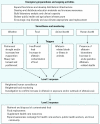Workgroup report: public health strategies for reducing aflatoxin exposure in developing countries
- PMID: 17185282
- PMCID: PMC1764136
- DOI: 10.1289/ehp.9302
Workgroup report: public health strategies for reducing aflatoxin exposure in developing countries
Abstract
Consecutive outbreaks of acute aflatoxicosis in Kenya in 2004 and 2005 caused > 150 deaths. In response, the Centers for Disease Control and Prevention and the World Health Organization convened a workgroup of international experts and health officials in Geneva, Switzerland, in July 2005. After discussions concerning what is known about aflatoxins, the workgroup identified gaps in current knowledge about acute and chronic human health effects of aflatoxins, surveillance and food monitoring, analytic methods, and the efficacy of intervention strategies. The workgroup also identified public health strategies that could be integrated with current agricultural approaches to resolve gaps in current knowledge and ultimately reduce morbidity and mortality associated with the consumption of aflatoxin-contaminated food in the developing world. Four issues that warrant immediate attention were identified: a) quantify the human health impacts and the burden of disease due to aflatoxin exposure; b) compile an inventory, evaluate the efficacy, and disseminate results of ongoing intervention strategies; c) develop and augment the disease surveillance, food monitoring, laboratory, and public health response capacity of affected regions; and d) develop a response protocol that can be used in the event of an outbreak of acute aflatoxicosis. This report expands on the workgroup's discussions concerning aflatoxin in developing countries and summarizes the findings.
Figures
References
-
- Bankole SA, Mabekoje OO. Occurrence of aflatoxins and fumonisins in preharvest maize from south-western Nigeria. Food Addit Contam. 2004;21(3):251–255. - PubMed
-
- Bolton MG, Munoz A, Jacobson LP, Groopman JD, Maxuitenko YY, Roebuck BD, et al. Transient intervention with oltipraz protects against aflatoxin-induced hepatic tumorigenesis. Cancer Res. 1993;53(15):3499–3504. - PubMed
-
- Brown R, Chen Z, Cleveland T, Russin J. Advances in the development of host resistance in corn to aflatoxin contamination by Aspergillus flavus. Phytopathology. 1999;89:113–117. - PubMed
-
- Brown RL, Chen ZY, Menkir A, Cleveland TE, Cardwell K, Kling J, et al. Resistance to aflatoxin accumulation in kernels of maize inbreds selected for ear rot resistance in West and Central Africa. J Food Prot. 2001;64(3):396–400. - PubMed
Publication types
MeSH terms
Substances
LinkOut - more resources
Full Text Sources


